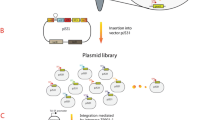Abstract
Directed enzyme evolution is now a routine approach to improve desirable biocatalytic properties. When only a low-throughput screen is available to detect improved variants from a mutant gene library, it is imperative that cloning efficiency be maximized during library synthesis to avoid wasting effort screening empty plasmids. To achieve this we developed pUCXKT, a gain-of-function positive selection expression vector. Insertion of genes amplified using a specialized downstream PCR primer restores key regulatory and genetic elements necessary for co-expression of a kanamycin resistance marker adjacent to the pUCXKT cloning region. We show that pUCXKT enables 100 % cloning efficiency as well as high-level expression of inserted genes. Unlike previous positive selection expression plasmids, the strategy we used to design pUCXKT is readily adaptable to different vector backbones, antibiotic marker genes, and multiple cloning regions.


Similar content being viewed by others
References
Ackerley DF, Ashoorzadeh A, Copp JN, Flanagan JU, Mowday AM, Patterson AV, Prosser GA, Smaill JB, Syddall SP, Williams EM (2012) International PCT patent WO/2012/008860.
Banerjee S, Kumar J, Apte-Deshpande A, Padmanabhan S (2010) A novel prokaryotic vector for identification and selection of recombinants: direct use of the vector for expression studies in E. coli. Microb Cell Fact 9:30
Bernard P, Gabant P, Bahassi EM, Couturier M (1994) Positive-selection vectors using the F plasmid ccdB killer gene. Gene 148:71–74
Bornscheuer UT, Huisman GW, Kazlauskas RJ, Lutz S, Moore JC, Robins K (2012) Engineering the third wave of biocatalysis. Nature 485:185–194
Datsenko KA, Wanner BL (2000) One-step inactivation of chromosomal genes in Escherichia coli K-12 using PCR products. Proc Natl Acad Sci USA 97:6640–6645
Haag AF, Ostermeier C (2009) Positive-selection vector for direct protein expression. Biotechniques 46:453–457
Lutz S (2010) Beyond directed evolution–semi-rational protein engineering and design. Curr Opin Biotechnol 21:734–743
Malo MS, Husain Z (2003) Positive selection vectors for high-fidelity PCR cloning. Biotechniques 34:1250–1258
Miura H, Inoko H, Inoue I, Tanaka M, Sato M, Ohtsuka M (2011) Simple cloning strategy using GFPuv gene as positive/negative indicator. Anal Biochem 416:237–239
Ohashi-Kunihiro S, Yohda M, Masaki H, Machida M (2007) A novel vector for positive selection of inserts harboring an open reading frame by translational coupling. Biotechniques 43:751–754
Prosser GA, Copp JN, Syddall SP, Williams EM, Smaill JB, Wilson WR, Patterson AV, Ackerley DF (2010a) Discovery and evaluation of Escherichia coli nitroreductases that activate the anti-cancer prodrug CB1954. Biochem Pharmacol 79:678–687
Prosser GA, Patterson AV, Ackerley DF (2010b) uvrB gene deletion enhances SOS chromotest sensitivity for nitroreductases that preferentially generate the 4-hydroxylamine metabolite of the anti-cancer prodrug CB1954. J Biotechnol 150:190–194
Prosser GA, Copp JN, Mowday AM, Guise CP, Syddall SP, Williams EM, Horvat CN, Swe PM, Ashoorzadeh A, Denny WA, Smaill JB, Patterson AV, Ackerley DF (2013) Creation and screening of a multi-family bacterial oxidoreductase library to discover novel nitroreductases that efficiently activate the bioreductive prodrugs CB1954 and PR-104A. Biochem Pharmacol 85:1091–1103
Swe PM, Copp JN, Green LK, Guise CP, Mowday AM, Smaill JB, Patterson AV, Ackerley DF (2012) Targeted mutagenesis of the Vibrio fischeri flavin reductase FRase I to improve activation of the anticancer prodrug CB1954. Biochem Pharmacol 84:775–783
Tang L, Gao H, Zhu X, Wang X, Zhou M, Jiang R (2012) Construction of “small-intelligent” focused mutagenesis libraries using well-designed combinatorial degenerate primers. Biotechniques 52:149–158
Turner NJ (2009) Directed evolution drives the next generation of biocatalysts. Nat Chem Biol 5:567–573
Acknowledgments
This research was supported by Genesis Oncology Trust (contract GOT-1252-RPG) and Marsden Research Fund (contract number VUW0901) grants to DFA. GAP and EMW were supported by Tertiary Education Commission Top Achiever Doctoral Scholarships. EMW received salary support from the Cancer Society of New Zealand (contract 13/01).
Author information
Authors and Affiliations
Corresponding author
Additional information
Gareth A Prosser and Elsie M Williams contributed equally to this work.
Rights and permissions
About this article
Cite this article
Prosser, G.A., Williams, E.M., Sissons, J.A. et al. A gain-of-function positive-selection expression plasmid that enables high-efficiency cloning. Biotechnol Lett 37, 383–389 (2015). https://doi.org/10.1007/s10529-014-1673-4
Received:
Accepted:
Published:
Issue Date:
DOI: https://doi.org/10.1007/s10529-014-1673-4




